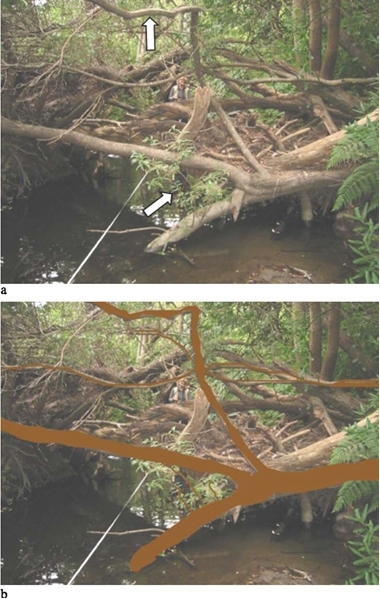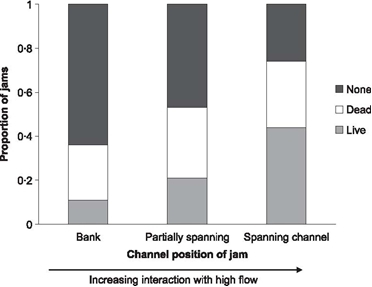Living Hardwoods: Necessary to California's freshwater aquatic ecosystems
California’s hardwoods have so many virtues it is difficult to count them all. Only recently scientists have come to appreciate the influence that living hardwoods exert on stream channel shape as the key to providing good habitat for all aquatic species, including salmon in coastal California streams. It is well known that wood in streams provides habitat for a broad range of fresh water species and can influence the shape of the stream channel and important ecosystem processes, such as moving sediment and nutrient cycling. Wood also provides important habitat for fish by creating pools, providing shade and hiding places from predators, protection from high flows, food and shelter for invertebrates, woodjams that store spawning gravels and organic matter, and facilitates riparian plant regeneration. Wood is considered one of the most important habitat components for anadromous salmonids and with salmon on the decline it is important we ensure the presence of wood in California’s coastal streams.
Previously, scientists attributed all of these qualities to large pieces of dead wood from species that rot slowly such as the infamous California redwoods. But this begs the question: What is happening in streams lined by hardwoods such as California bay laurel, live oaks, alders, and willows commonly found in our mediterranean-climate woodlands? Field research conducted by Dr. Jeff Opperman, UC Berkeley alumnus now working for The Nature Conservancy, in 20 stream reaches in the northern parts of the San Francisco bay area, documents that living hardwoods are playing an essential role in California’s hardwood dominated streams by providing permanent structure that interacts with stream flow and gravel movement to create essential aquatic habitat for salmon and other native species (Figure 1).

Figure 1. Extracted from OPPERMAN, J. J. and A. M. MERENLENDER. 2007 Living trees provide stable large wood in streams. Earth Surface Processes and Landforms 32:1229-1238 (a) A red willow (Salix laevigata) that has fallen into Wildcat Creek (Aladmeda County, CA) but remains rooted and living (photo taken looking upstream).The lower arrow indicates sprouts growing from the lower branch of the willow. The upper arrow indicates a branch that has reoriented to become the primary source of photosynthesis for the fallen tree. A channel-spanning wood jam has accumulated upstream of this willow, which has contributed to the formation of the pool in the lower left portion of the picture. (b) The shaded areas denote all the wood that is still living within this wood jam.
As you can imagine trees that fall or grow over the stream and remain rooted and alive are more stable over time and and can withstand sizeable storms. After falling into the stream, hardwoods can often sprout new branches or bend into new shapes that result in vertical branches to capture more light for photosynthesis. A live tree spanning a creek with leaves on vertical branches creates significant shade and captures additional wood and organic material all to the benefit of the fish living below (Figure 1). These persistent hardwoods provide important in-stream structure in streams with riparian corridors that lack large conifers. In fact, in the 20 streams Jeff studied living hardwoods were the key piece of wood within a wood jam, the primary mechanism by which wood in?uences channel morphology, and had greater influence on channel morphology than larger pieces of dead wood found. Only 74% of the wood jams without live wood persisted to allow for scowering and pool formation in the stream over 1-2 years while 98% with living wood as a key piece remained in place for longer. Wood jams that span the entire channel provide the greatest influence over stream morphology and create complex habitat that maintains cooler safer waters for fish. Out of all the channel-spanning jams measured by Jeff, 44% had a living hardwood as key piece (Figure 2).

Figure 2. Extracted from OPPERMAN, J. J. and A. M. MERENLENDER. 2007 Living trees provide stable large wood in streams. Earth Surface Processes and Landforms 32:1229-1238 The proportion of all wood jams with a live key piece (shaded), dead key piece (white) or no key piece (black), based on channel position of the wood jam.
Clearly, California hardwoods are a necessary component within California’s fresh water aquatic ecosystems because they contribute to ?sh habitat by creating and maintaining wood jams, forming pools, and providing cover. Unfortunately, wood in streams is often removed by landowners, in some cases to protect property, but in other cases because of the desire for a clean stream or for easily accessible firewood. To stress the importance of maintaining wood in streams for fish habitat I, along with Jeff, and David Lewis a UCCE Watershed Management Advisor for Sonoma County, wrote a free publication for landowners titled “Maintaining wood in streams: A vital action for fish conservation.” Please click here to access the publication and learn more about this topic: http://ucanr.org/freepubs/docs/8157.pdf.